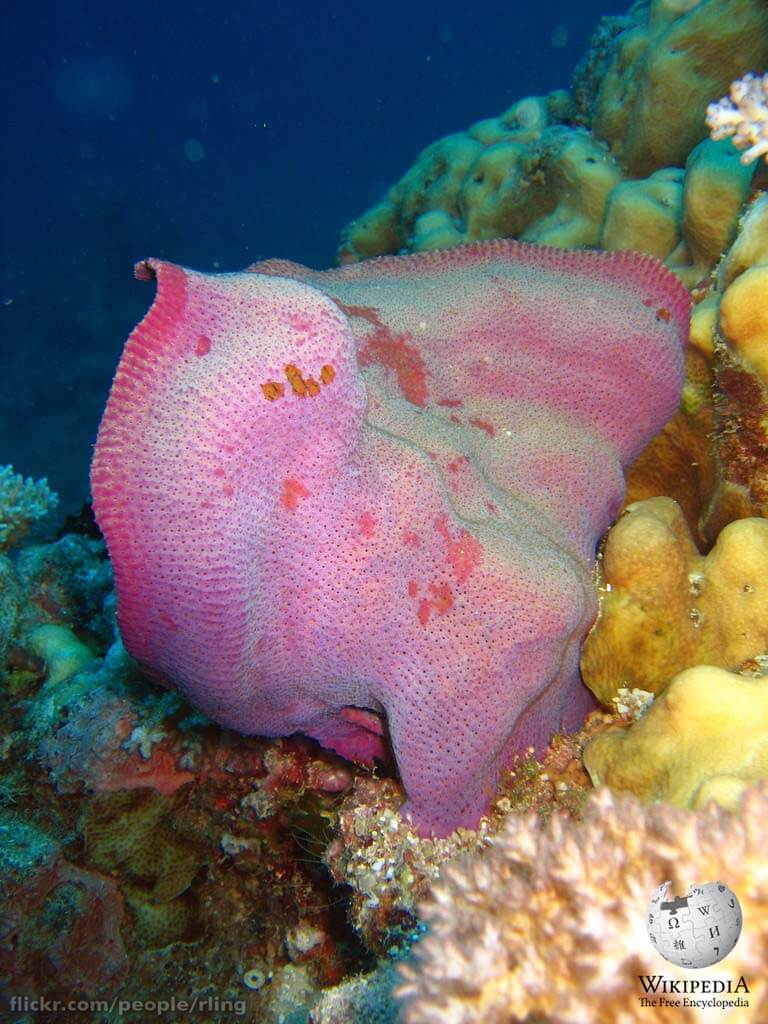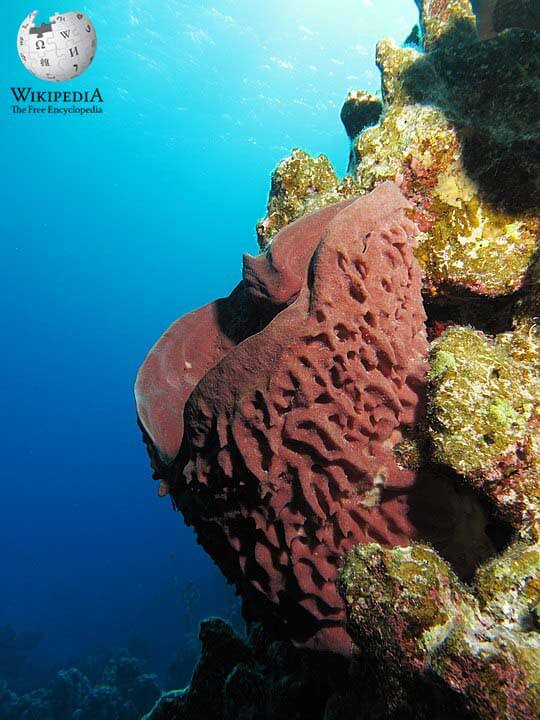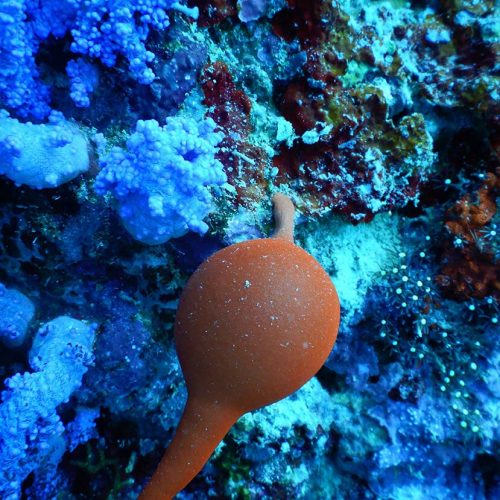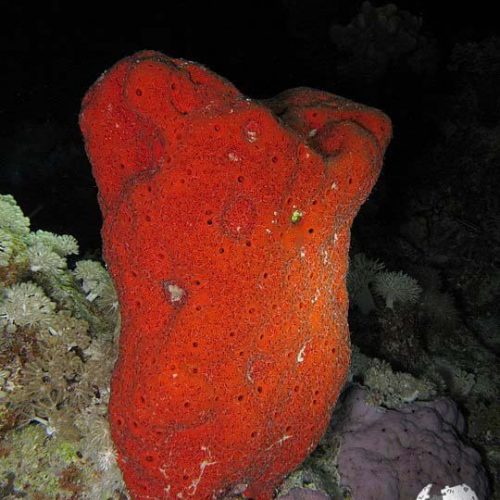Contents
Callyspongia crassa, commonly known as prickly tube-sponge, is a species of sponge found from the Red Sea to the Seychelles. Its wide flexible brown tube with exterior protuberances can appear as a single tube or as clusters of tubes and can reach up to 50 centimeters (20 inches) in size.[1][2][3] Like many other sea sponges, it is primarily used for marine drugs as they have many bioactive components and properties.[4] They also play an important role in marine reef and benthic communities, as they constantly filter water and act as habitats for smaller organisms.[5][6] As sea sponges, they have the ability to reproduce both sexually and asexually.[7]
Naming and taxonomy
The name crassa derives from the Latin word crassus meaning solid, thick, fat, or dense.[8] Its common name, the prickly tube-sponge, comes from its physical appearance as it is a tube sponge and it is nearly completely covered in spines.[9] It was previously named Sclerochalina crassa, but was eventually moved to the genus Callyspongia.[2][10]
The genus Callyspongia belongs to the family Callyspongiidae. This family contains four genera: Arenosclera, Callyspongia, Dactylia, and Siphonochalina with Callyspongia being the largest and containing over 180 species.[11] They are under the phylum Porifera, making them a sponge. Specifically, they are Demosponges, which is the most diverse class in the phylum Porifera.[12]
Description
The prickly tube-sponge is a large, flexible, brown, sometimes red, tube that can be found as a singular tube or as a cluster. It has been known to reach up to 50 centimeters (~20 inches) with specimens as small as 2 mm having been found, but it typically has an average diameter of 30 centimeters (~12 inches). Most of its surface is covered with spines or spine-like protrusions which tend to taper away towards the upper part of the tube.[2][4][9]
Gallery
Utility
The main use of these sponges is for marine drugs.[4] Many species of sponge are used for marine drugs due to their bioactive components, many of which are used for antiseptic agents.[4][9] Callyspongia crassa has over 20 compounds that attribute to its medical content. Such compounds contain many biological properties such as anti-oxidant, decrease blood cholesterol, anti-inflammatory, anti-fungal, anti-microbial, cancer-preventive, hypercholesterolemia, nematicide, anti-cancer, anti-tumor, pesticide, lubricant, anti-androgenic, flavor, anti-bacterial, anti-tumor cytotoxic effects, anti-arthritic, anti-asthma, diuretic, and anti-diabetic abilities.[9]
Sea sponges are also of important use in the wild. They play an important role in nutrient recycling and in filtering the water[5] which is useful for many of the reefs that they live in as clearer water makes sunlight more accessible for photosynthesizing organisms in the same area.[13] Many sponges also serve as a habitat for a variety of other organisms. They can serve as microhabitats,[5] with conditions different from the larger surrounding area. Tube sponges specifically, often have small fish and other inhabitants living inside of the tubes.[6]
Ecology
Habitat
These sponges are native to the Red Sea. Samples have been found in the southern Red Sea off the coasts of Sudan and Eritrea[2] and in the northern Red Sea in the Gulf of Aqaba at Eilat.[4][9] They are known to live in marine reef and marine benthic habitats, relatively close to shore.[2] They have been found between a depth of 1–30 m, but they are more abundant at deeper depths (15–30 m).[4] They live in waters with high salinity and warm temperatures, with water in the Red Sea never dropping below 21 °C (70 °F).[10]
Feeding
Callyspongia crassa are filter feeders and suspension feeders, but they mainly filter feed.[2] They filter feed because they lack true tissues and organs, so they can not have a digestive system similar to other animals.[14][15] This sponge filter feeds by taking in water towards the base, filtering it to get the nutrients and food, and then expelling the leftover water out through the osculum.[16] They are omnivores as their diet consists of both small plants and animals.[3]
Reproduction
Sea sponges can reproduce both sexually and asexually. They often switch between the two seasonally, to best grow their populations and take up space on the reef.[7][17]
References
- ^ Lieske, Ewald; Myers, Robert (2004). Coral reef guide. Red Sea. HarperCollins. p. 238. ISBN 9780007741731.
- ^ a b c d e f World Porifera Database - Species - Callyspongia crassa (Keller, 1889)
- ^ a b "Callyspongia crassa (Keller 1889) - Encyclopedia of Life". eol.org. Retrieved 2022-04-26.
- ^ a b c d e f Ibrahim, Hassan A. H.; El-Naggar, Hussein A.; El-Damhougy, Khalied A.; Bashar, Mansour A. E.; Abou Senna, Fekry M. (2017-12-15). "Callyspongia crassa and C. siphonella (Porifera, Callyspongiidae) as a potential source for medical bioactive substances, Aqaba Gulf, Red Sea, Egypt". The Journal of Basic and Applied Zoology. 78 (1): 7. doi:10.1186/s41936-017-0011-5. ISSN 2090-990X. S2CID 26352520.
- ^ a b c Singh, Anshika; Thakur, Narsinh L. (22 December 2017). "Influence of spatial competitor on asexual reproduction of the marine sponge Cinachyrella cf. cavernosa (Porifera, Demospongiae)". Hydrobiologia. 809: 247–263. doi:10.1007/s10750-017-3470-2. S2CID 3320898.
- ^ a b Majoris, John E.; Francisco, Fritz A.; Atema, Jelle; Buston, Peter M. (20 January 2018). "Reproduction, early development, and larval rearing strategies for two sponge-dwelling neon gobies, Elacatinus lori and E. colini". Aquaculture. 483: 286–295. doi:10.1016/j.aquaculture.2017.10.024.
- ^ a b Ereskovsky, Alexander V.; Geronimo, Alexia; Pérez, Thierry (10 October 2017). "Asexual and puzzling sexual reproduction of the Mediterranean sponge Haliclona fulva (Demospongiae): life cycle and cytological structures" (PDF). Invertebrate Biology. 136 (4): 403–421. doi:10.1111/ivb.12195.
- ^ Lewis, Charlton Thomas (1918). An elementary Latin dictionary, with an appendix of names of persons and places met in the Latin authors commonly studied in the first two years of the college course. Harold B. Lee Library. New York, American book company.
- ^ a b c d e K.A., El-Damhougy; Bashar, Mansour A.E.; El-Naggar, Hussein A.; Ibrahim, Hassan A.H.; Abou Senna, Fekry M. (March 2017). "GC-MS ANALYSIS OF BIOACTIVE COMPONENTS OF CALLYSPONGIA CRASSA (PORIFERA) FROM GULF OF AQABA RED SEA (EGYPT)". Al Azhar Bulletin of Science. 9.
- ^ a b Voolstra, Christian R.; Berumen, Michael L. (2019). Coral Reefs of the Red Sea. Springer.
- ^ "WoRMS - World Register of Marine Species - Callyspongiidae Laubenfels, 1936". www.marinespecies.org. Retrieved 2022-04-26.
- ^ "World Porifera Database". www.marinespecies.org. Retrieved 2022-04-26.
- ^ Fourney, Francesca; Figueiredo, Joana (28 September 2017). "Additive negative effects of anthropogenic sedimentation and warming on the survival of coral recruits". Scientific Reports. 7 (1): 12380. Bibcode:2017NatSR...712380F. doi:10.1038/s41598-017-12607-w. PMC 5620051. PMID 28959051.
- ^ "Structure of Sponges - Biodiscovery and the Great Barrier Reef". Queensland Museum. Retrieved 2022-04-26.
- ^ Thacker, Robert W; Díaz, Maria Cristina; Kerner, Adeline; Vignes-Lebbe, Régine; Segerdell, Erik; Haendel, Melissa A; Mungall, Christopher J (2014-09-08). "The Porifera Ontology (PORO): enhancing sponge systematics with an anatomy ontology". Journal of Biomedical Semantics. 5 (1): 39. doi:10.1186/2041-1480-5-39. ISSN 2041-1480. PMC 4177528. PMID 25276334.
- ^ Ruppert, Edward E.; Fox, Richard S.; Barnes, Robert D. (2004). Invertebrate zoology : a functional evolutionary approach. Internet Archive. Belmont, CA : Thomson-Brooks/Cole. ISBN 978-0-03-025982-1.
- ^ Zilberberg, C.; Solé-Cava, A.M.; Klautau, M. (5 September 2006). "The extent of asexual reproduction in sponges of the genus Chondrilla (Demospongiae: Chondrosida) from the Caribbean and the Brazilian coasts". Journal of Experimental Marine Biology and Ecology. 336 (2): 211–220. doi:10.1016/j.jembe.2006.05.010.











